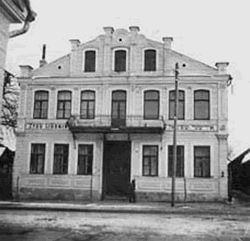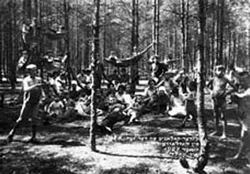Panevezys
Stories
Paneve×ys
Paneve×ys, Paneve×ys County, Lithuania

The Jewish Hospital
YVA, Photo Collection 1131/41

Pre-war Jewish summer camp in the Kaizerlingas Forest, the site where Germans murdered Jews in 1941
YVA, Photo Collection 4156
Jews began settling in Panevezys at the beginning of the eighteenth century. By 1923, Panevezys, the fourth largest town in Lithuania, had a Jewish population of 6,845, accounting for 36 percent of the total population. Panevezys was renowned for its many Jewish communal institutions, notably the Great Yeshiva founded by Rabbi Josef Kahaneman, the town’s chief rabbi. The Great Yeshiva was set up on the grounds of the Kibbutz Haponevezhi Yeshiva, which had been founded in 1909 by Rabbi Yitzhak Yaakov Rabinovich (Rabbi Izale Ponevezer).
Following the Soviet annexation of Lithuania in 1940, all shops and factories in Panevezys, many of them Jewish owned, were nationalized. Most Jewish educational and cultural institutions were closed.
The German army occupied Panevezys on June 26, 1941. Local nationalists immediately launched an assault on the local Jewish population, and dozens were murdered.
On July 7, 1941, the Jews of Panevezys were forced into a ghetto along with Jews from Naujamiestis, Krekenava, Raguva and Ramygala. The ghetto area was confined to several of the town’s streets.
The entire population of the ghetto was murdered in August 1941.
The Red Arm